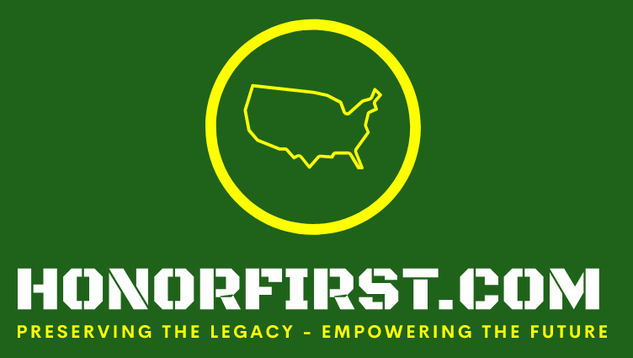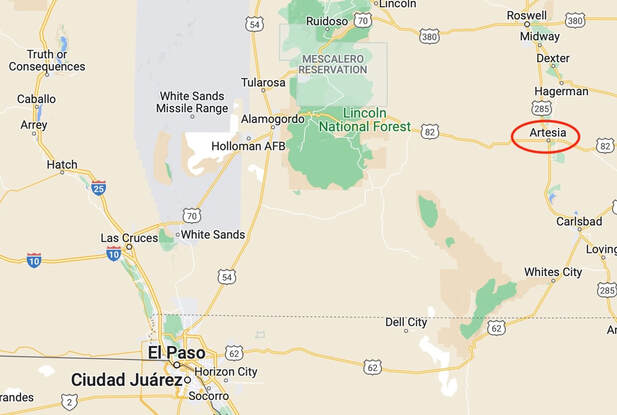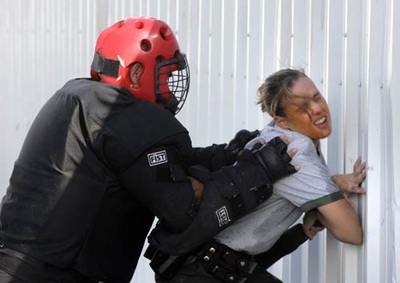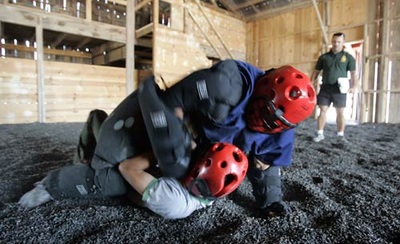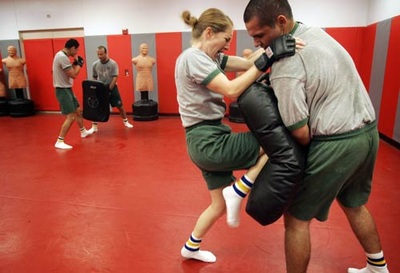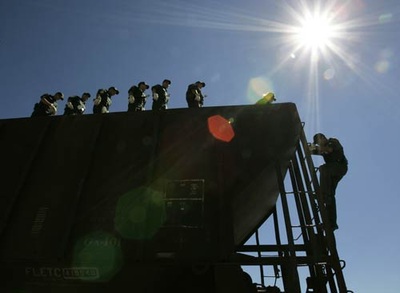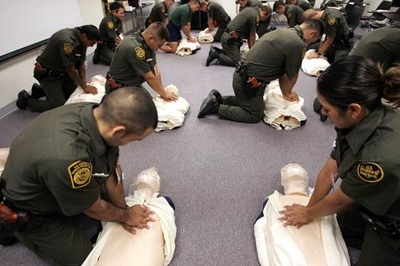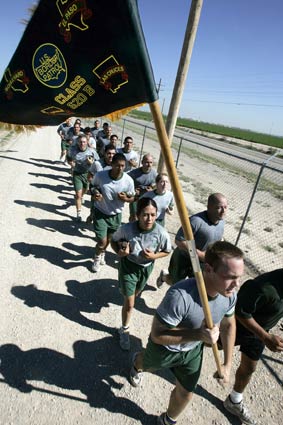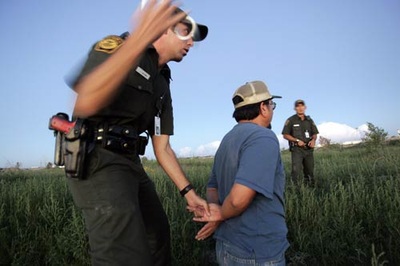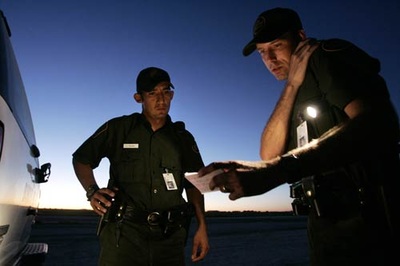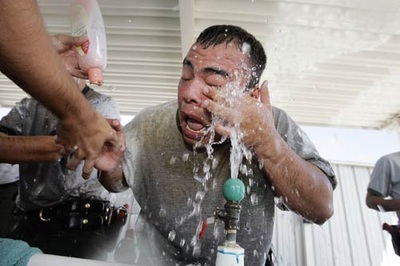The Border Patrol Academy
As you read this page, we understand the challenges of applying for the United States Border Patrol. To better support you, we're introducing two friendly partner platforms: the United States Border Patrol Applicant's sub-Reddit and the Border Patrol Agent Hiring Process Facebook group.
These communities offer additional resources alongside our Delphi forum, which prides itself on providing accurate information for over 20 years. We encourage you to explore all platforms for diverse insights and advice. Remember, our Delphi forum remains a valuable resource for expert guidance on your USBP journey.
These communities offer additional resources alongside our Delphi forum, which prides itself on providing accurate information for over 20 years. We encourage you to explore all platforms for diverse insights and advice. Remember, our Delphi forum remains a valuable resource for expert guidance on your USBP journey.
USBP Academy Statistics for 2023
Basic Academy for United States Border Patrol Agents Overview:
Border Patrol Processing Coordinator (BPPC) Highlights:
- Classes Graduated: A total of 22 classes successfully completed their training at the basic academy.
- New Agents: Proudly welcomed 777 new agents into the force.
- Gender Breakdown: Of these, 689 were male and 85 were female.
- Training Hours: Agents underwent a rigorous training program totaling 20,592 hours.
- Training Days: This comprehensive training spanned across 2,574 days.
Border Patrol Processing Coordinator (BPPC) Highlights:
- Classes Graduated: Successfully graduated 19 classes from both Artesia and Charleston locations.
- New BPPCs: A total of 734 new Border Patrol Processing Coordinators joined the team.
- Gender Breakdown: Achieved a balanced intake with 372 males and 362 females.
- Training Hours: Coordinators completed 5,472 hours of specialized training.
- Training Days: Their training extended over 684 days, ensuring proficiency and readiness.
Watch These CBP Videos
|
Are you ready for one of the greatest challenges of your life? The United States Border Patrol Academy is recognized as one of the most difficult and challenging law enforcement academies in the world. To graduate from the demanding 6-month academy, all new hires must pass practical and written tests in driving, firearms, Spanish, and physical techniques. If you are ready for a rewarding career dedicated to protecting our country, apply now at www.cbp.gov/careers
|
|
It's the test of their lifetime at the U.S. Border Patrol Academy in Artesia, New Mexico. The training is exhausting both physically and mentally. CBS 4 Reporter Sydney Hernandez was given rare access inside the training facility and reports first hand what it takes to be responsible to secure our borders.
|
|
If you’re interested in becoming a Border Patrol Agent, it’s important that you’re prepared to attend the U.S. Border Patrol Academy in Artesia, New Mexico. It’s here that new recruits learn the physical, technical, and mental skills they’ll need on the job. This video breaks down what you need to know about preparing to attend the academy, what you'll learn while you're there, life at the academy, and next steps after graduating.
|
|
Are you ready for one of the greatest challenges of your life? The United States Border Patrol Academy is recognized as one of the most difficult and challenging law enforcement academies in the world. To graduate from the demanding 6-month academy, all new hires must pass practical and written tests in driving, firearms, Spanish, and physical techniques. If you are ready for a rewarding career dedicated to protecting our country, apply now at www.cbp.gov/careers
|
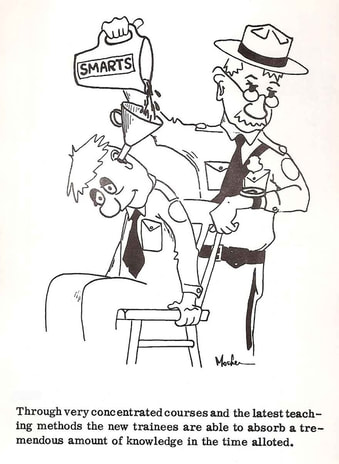
Q. What is the Academy like?
A. Physically, it is not quite as tough as Marine Corps Boot Camp. You will not get the mind games that you get in boot camp, but you will be challenged mentally by the course work. As one trainee agent once stated, "It's like college with a purpose." You have to learn Spanish while you are there if you are not already fluent. Native speakers get basically the same course as everyone else. This is subject to change as the academy is looking at eliminating the Spanish portion for those who can test out.
You will be physically conditioned; you will learn police science; you will push yourself to the limits of endurance. You will learn to use a firearm and become proficient in its use. It will become molded to your body and if and when the time comes, you will be ready. You will attain driving skills similar to those of a professional race car driver. You will become intimately familiar with Immigration Law.
Many prospective applicants write asking if such and such a height and weight will be OK to enter the academy. If you have to ask, you should probably start a PT program right now. A quote from an trainee who is about half way through the Academy: "A word of advice you may pass on to those who inquire is that it is very important that they are in good physical shape PRIOR to reporting for duty. I've seen too many people there who have to struggle that much harder in order to pass one of the easiest things to pass (that being PT). I believe the right shape and proper attitude are essential ingredients to success at the academy."
Your time after work is your own. This is not boot camp! When the day is over, while you are expected to complete homework, what you do on your own time is your decision. There will be times during the academy training that you will be expected to work at night. Food and lodging is provided at no cost to you. Did I mention the maid service?
A. Physically, it is not quite as tough as Marine Corps Boot Camp. You will not get the mind games that you get in boot camp, but you will be challenged mentally by the course work. As one trainee agent once stated, "It's like college with a purpose." You have to learn Spanish while you are there if you are not already fluent. Native speakers get basically the same course as everyone else. This is subject to change as the academy is looking at eliminating the Spanish portion for those who can test out.
You will be physically conditioned; you will learn police science; you will push yourself to the limits of endurance. You will learn to use a firearm and become proficient in its use. It will become molded to your body and if and when the time comes, you will be ready. You will attain driving skills similar to those of a professional race car driver. You will become intimately familiar with Immigration Law.
Many prospective applicants write asking if such and such a height and weight will be OK to enter the academy. If you have to ask, you should probably start a PT program right now. A quote from an trainee who is about half way through the Academy: "A word of advice you may pass on to those who inquire is that it is very important that they are in good physical shape PRIOR to reporting for duty. I've seen too many people there who have to struggle that much harder in order to pass one of the easiest things to pass (that being PT). I believe the right shape and proper attitude are essential ingredients to success at the academy."
Your time after work is your own. This is not boot camp! When the day is over, while you are expected to complete homework, what you do on your own time is your decision. There will be times during the academy training that you will be expected to work at night. Food and lodging is provided at no cost to you. Did I mention the maid service?
Last year some courses were cut out of the curriculum as it was felt that they could be presented in a computer based learning format (ie, FLETC courses). This changed the Academy from 91 days to 81 days.
The Academy is on a 55 day program. Spanish is dropped from the first part of the curriculum. Instead a Tasked Based Language course has been developed for those who need to become functionally fluent in Spanish. A test will be administered at the Academy to see who needs to attend that five week course. Those who show fluency in Spanish will be released back to their station after successful completion of the 55 day program.
The PT change on the C-Course is that the horizontal rope has been lowered two feet. Since the majority of that obstacle is crossing it, not dropping off of it, the change is fairly moot. Too many injuries were being attributed to either falling or landing improperly.
Q. Is e-mail and/or internet access available to students at the FLETC?
A. Yes, internet accessible computers are available in the student center
There is also a commercial Internet provider that you can purchase for the time you will be at the academy. This is a wireless setup and you can use the service in your dorm room.
You may also access your personal e-mail or internet account from the dorm room phone line. To do so, you must have your own computer and be able to access your Internet Service Provider (ISP) either by a local (Artesia, NM) phone number or by using a toll free number provided by the ISP. Cell phone cards are available from some providers that slide into the card slot of your laptop. You can use your computer for internet anywhere you can hit a cell tower.
The Academy is on a 55 day program. Spanish is dropped from the first part of the curriculum. Instead a Tasked Based Language course has been developed for those who need to become functionally fluent in Spanish. A test will be administered at the Academy to see who needs to attend that five week course. Those who show fluency in Spanish will be released back to their station after successful completion of the 55 day program.
The PT change on the C-Course is that the horizontal rope has been lowered two feet. Since the majority of that obstacle is crossing it, not dropping off of it, the change is fairly moot. Too many injuries were being attributed to either falling or landing improperly.
Q. Is e-mail and/or internet access available to students at the FLETC?
A. Yes, internet accessible computers are available in the student center
There is also a commercial Internet provider that you can purchase for the time you will be at the academy. This is a wireless setup and you can use the service in your dorm room.
You may also access your personal e-mail or internet account from the dorm room phone line. To do so, you must have your own computer and be able to access your Internet Service Provider (ISP) either by a local (Artesia, NM) phone number or by using a toll free number provided by the ISP. Cell phone cards are available from some providers that slide into the card slot of your laptop. You can use your computer for internet anywhere you can hit a cell tower.
Q. Where in the world is Artesia, NM?
Artesia is 40 miles south of Roswell – the Alien Capital of the World! - and 25 miles north of Carlsbad, home of the Carlsbad Caverns National Park.
Do the dorm rooms have phones? Yes, all of our dorm rooms have telephones! We are very proud to say they also have televisions with cable and remote controls. Just like home! Or at least close!
What is the weather like in Artesia? Artesia has a wide-range of temperature fluctuations. Summers are warm, 90+, but with very low humidity. Evenings, even in the summer, can drop in the 50’s. Winters are fairly mild, average temperatures in the daytime between 40-50, but it can snow! Spring winds can be a problem, but survivable.
What is there to do in Artesia during off-duty time? Artesia is a small community, population 10,000, but because of its location, there are many wonderful sites to see. The mountains are an hour’s drive east, Carlsbad Caverns half-hour to the south, and shopping north to Roswell and the Alien Museum. Check out our Artesia FLETC home page for more information. The Center does provide shuttle bus service nightly to downtown for movies and shopping.
Artesia is 40 miles south of Roswell – the Alien Capital of the World! - and 25 miles north of Carlsbad, home of the Carlsbad Caverns National Park.
Do the dorm rooms have phones? Yes, all of our dorm rooms have telephones! We are very proud to say they also have televisions with cable and remote controls. Just like home! Or at least close!
What is the weather like in Artesia? Artesia has a wide-range of temperature fluctuations. Summers are warm, 90+, but with very low humidity. Evenings, even in the summer, can drop in the 50’s. Winters are fairly mild, average temperatures in the daytime between 40-50, but it can snow! Spring winds can be a problem, but survivable.
What is there to do in Artesia during off-duty time? Artesia is a small community, population 10,000, but because of its location, there are many wonderful sites to see. The mountains are an hour’s drive east, Carlsbad Caverns half-hour to the south, and shopping north to Roswell and the Alien Museum. Check out our Artesia FLETC home page for more information. The Center does provide shuttle bus service nightly to downtown for movies and shopping.
Q. I am a little concerned about the PT at the Academy. Should I be?
A. Yes. Below is a post that I copied from the message board that pretty well describes what you should be doing to get ready: First the run is 13 minutes or less. PT sessions last for two hours. You will do it every other day starting your second week, then every day after week nine. If you wanna get ready this is what you need to do. Now don't get all freaked out by this, just start and give it a honest effort. Here goes.....You're gonna get suited out and go into a mat room, there you will do maybe ten minutes of stretching. Then you're gonna do sit-ups, no set number. My suggestion is to be able to do thirty to forty with ease. When you do them, do them until you cannot get off the ground again, not until you get lazy. Sometimes you will do 4 counts, sometimes diamonds where your hands are together under your chest in a diamond pattern (close together) and some times you will do (I'm not joking here) knuckles, where you do pushups on your knuckles. All of these will be done in the following manner...all the way up, all the way down to within one fist of the mat. When you can't do any more get on your back and do crunches (don't put your knees on the ground during transition, or ever for that matter) until you cant do anymore, not until you get lazy. My suggestion 200, and keep your head off the mat. Its not a pillow! Then back to pushups, select a different form, diamonds, four count military (if you don't know ask someone who can show you) wide stance, knuckles, until exhausted. Back to sit-ups, knee rock backs, leg lifts or some other kind of ab work out. You get to where you can do this for 45 minutes straight then you will have the mat room down. Then you get a drink and run. We went on runs that were over 4 miles. Not often but they happened. My suggestion....Be able to run 4 miles nonstop, don't worry about the time but don't walk! Never walk unless you've already passed out or if you think you need medical assistance. Then you will finish off when you get back with 10 4-count pushups (which is really 20) or pull ups. After 9 weeks you may catch a break here and there and do the weight room instead of running depending on your instructors. Then you're gonna run in and take a two minute helicopter shower (run in, twirl around and run out) and then try to change with 50 other guys in a room the size of a McDonald's dining area. Ok? That's the routine in a nut shell. This may be just a little more that will be required but better to be a leg up. You know what to do which is more than we had so go do it. If you think I'm full of BS then don't do it, I don't care. But if you chose to wait for the academy because you don't feel like doing it now, or you can't believe what you've read, then just do me one favor...Think of this post on your first day of PT. I took the time to post this and you all have the time to do it, don't let it go to waste! You are gonna have enough academics to review at night without having to go to PT remedials. If you think this all sounds too hard to do now wait till you get to the academy and have Spanish and law heaped on your plate. Q. Do I get paid while at the Academy? A. Yes. You receive full pay while at the Academy. In addition to your GS-5 (or GS-7 or 9, depending on qualifications) pay, you also receive a small amount of per diem ($5) to cover the costs of incidental expenses. Q. What should I wear while awaiting uniforms at the academy? A. You may wear clean, neat conservative attire, shirts must have a collar. Jeans are prohibited for on duty wear. Trousers similar to Dockers are preferred. Suits and ties are not required. Currently, generic uniforms are being issued for your use while waiting for uniforms. Q. Will we get any time off between the academy and our duty station? A. You will be given the opportunity to apply for leave toward the end of training. You will probably accumulate about 40 hours (one week) of leave during training. Add to this your two days off on both ends and you can be off for about nine days before going to work. For you folks who have served in the military, your two days off each week are not deducted from your leave balance. Example: If you have Sunday and Saturday off (work week is Sun - Sat) you can request Monday through Friday as leave days and be off a total of nine days. Q. How much money do I need to bring with me when I report for duty? A. Another difficult question to answer. This depends a lot on you, but at a minimum, plan for three days of hotel room cost (be sure to request the government rate), plus food and transportation. You should bring about $300 more for incidentals. You will be issued uniforms to wear during training. After you report for duty, you are given $1000 initially for uniforms in the form of credits to be applied to your account. Sorry, no cash. All uniforms are purchased from a contract provider.
Q. Where is the Academy?
A. The Academy is located at the Federal Law Enforcement Training Center (FLETC) in Artesia, NM. Q. Can I bring my car to the Academy? What about my wife/husband/kids? A. You can bring your car to Artesia, but parking may be at a premium, so this could change at any time. Your off duty hours will be consumed by study and the distractions of a family life prove to be too much for most trainees. Rentals for your family are almost impossible to find. A car tends to be another distraction since all of your classmates want to go here and there and guess who drives? Getting the car there is also a major problem since you MUST travel by government transport from your O.S. A better solution is to rent a car on weekends if you would like to tour the area. There are quite a few entertainment options, such as Roswell (Alien Capital, USA) NM, Carlsbad Caverns, Inn of the Mountain Gods Casino and Resort, and Cloudcroft, NM. Q. Do the trainees who are at the Academy have any advice for those of us who are just getting started? A. Start getting in shape NOW, even if you THINK you are in pretty good condition, especially running and upper body. Travel light. You don't have a lot of storage space in your room. Prepare yourself mentally for a challenge. There might be a place to hook up your modem, and you probably WILL have a phone in your room. A computer will be handy if you have one but they are available there. Word for Windows would make it even better. Bring the best running shoes you can afford, and two pair would be even better to alternate. You will be issued a combo backpack/camelbak to carry your goodies at the academy. You must use this and only this item to tote your stuff.
Boots: You must wear issued tan Danners. Your ostrich skin pointy toed bull riders ain't gonna get it.
These are items mentioned by a BPA(t)'s wife who visited him at the Academy:
Court shoes are NOT a requirement.
- Running shoes
- A couple of changes of clothes - must be slacks or khaki's with button down shirts or polo type shirts, everything must be neat. NO SHORTS IN CLASS. You won't need these clothes as much once you get your uniform to wear everyday in class. It will take about 4 weeks for you to be in your BP uniform in class. You will get a generic FLETC uniform to wear while waiting for your BP greens.
- Lounge clothes. After 4:30 p.m. it's your time, you can wear pretty much what you want.
- Index cards - about 4 packs (also WalMart)
- Laundry soap, fabric softener (can be bought locally).
- Iron, unless you want to pay around $8.00 a week or more for laundry and pressing.
- Plus any other miscellaneous personal items you can not live without.
The information below mirrors the CBP Border Patrol Academy article and is copied here to assist the applicant in the event the article is deleted.
Title - CBP Border Patrol Academy
Summary - What information is there about the Border Patrol Agent Academy?
Date Published - 12/19/2022 1:37 PM
Content -
The Border Patrol Academy is recognized as having one of the most challenging curriculums in federal law enforcement. All newly hired Border Patrol Agents receive their basic law enforcement skills by attending the Academy. Additionally, trainees who successfully pass all aspects of academy training are eligible for up to 18 college credit hours towards an accredited degree.
Each Border Patrol Agent trainee must complete a 940 hour (117 training days) paid, resident course of instruction in U.S. law, Border Patrol operations, physical training, firearms instruction, driving, law enforcement and Border Patrol tactical training, and Spanish. Student assessments vary from online, knowledge-based, multiple-choice exams to diverse and rigorous performance-based integrated scenarios. Border Patrol trainees must maintain a passing score in all courses of instruction in order to be retained.
The Academy law program consists of three (3) separate courses.
The Physical Techniques Department’s (PTD) curriculum is designed to develop officer presence and increase the mental, physical, and cardiovascular capabilities of a U.S. Border Patrol agent. The 178-hour curriculum blends physical conditioning, defensive tactics and less-lethal training to emphasize agent survival and safety and prepare trainees for the physical demands of the job. Instruction in arrest techniques, collapsible straight baton (CSB), oleoresin capsicum spray (OC), individual first aid kit (IFAK), less lethal equipment, ground defense, and edge weapons defense training builds trainee confidence and prepares each trainee for the rigors of being a U.S. Border Patrol agent. The Physical Techniques final exam consists of:
The Firearms Training Department (FTD) provides 133 hours of instruction, focused on:
The U.S. Border Patrol Academy’s Driver Training Department (DTD) curriculum is designed to prepare students with the driving ability, tactical skills, and occupational knowledge required to work as a law enforcement professional. The 86 hours of instruction is 20% classroom time and 80% practical exercises. Core subjects include searching conveyances, safe driving principles, operation of patrol vehicles, four-wheel drive operations, and emergency driving techniques.
Students must pass three practical examinations as a condition of employment. Then, students advance to vehicle stops, pursuit driving, controlled tire deflation devices, and offensive driving techniques. Driver’s training culminates with post offensive driving techniques vehicle stop scenarios, as students must use a principle-based approach to resolve unconventional situations in real-time. The final eight hours, conducted during night hours, consists of four-wheel drive, vehicle pursuits, offensive driving techniques maneuvers, and low and high-risk vehicle stops.
Tactics training consists of 107 hours of curriculum that bridges lessons from both firearms and physical techniques. Tactics lessons focus on the application (skills and knowledge) of
Spanish Language Training enables trainees to communicate effectively with those people they will encounter in the field who speak only Spanish. This is a critical element of the job because over 90% of the more than one million undocumented non-citizens apprehended each year speaks only Spanish.
The Spanish taught at the Border Patrol Academy is very specialized. Our staff provides 182 hours of program instruction.
Students must be able to understand and employ law enforcement-specific language unique to the Border Patrol Agent's work environment as well as be able to solicit information and use colloquial phrases and idiomatic expressions.
Additional content includes concurrent basic Spanish grammar to aid in language retention. Instructors use a wide variety of the most modern methods available in second language acquisition methodology to provide students with an exciting, creative, and challenging course that will enable them to remain safe and effective in the field.
Title - CBP Border Patrol Academy
Summary - What information is there about the Border Patrol Agent Academy?
Date Published - 12/19/2022 1:37 PM
Content -
The Border Patrol Academy is recognized as having one of the most challenging curriculums in federal law enforcement. All newly hired Border Patrol Agents receive their basic law enforcement skills by attending the Academy. Additionally, trainees who successfully pass all aspects of academy training are eligible for up to 18 college credit hours towards an accredited degree.
Each Border Patrol Agent trainee must complete a 940 hour (117 training days) paid, resident course of instruction in U.S. law, Border Patrol operations, physical training, firearms instruction, driving, law enforcement and Border Patrol tactical training, and Spanish. Student assessments vary from online, knowledge-based, multiple-choice exams to diverse and rigorous performance-based integrated scenarios. Border Patrol trainees must maintain a passing score in all courses of instruction in order to be retained.
The Academy law program consists of three (3) separate courses.
- Applied Authorities is 46 hours of instruction and covers the structure and function of the United States Government, limitations of law enforcement authority, a Border Patrol agent’s statutory authority, federal criminal statutes, criminal and administrative rights warnings, and an introduction to criminal procedures and professional liability issues.
- Administrative Law is a combination of nationality law (12 hours) and immigration law (44 hours). Nationality law focuses on determining citizenship and includes an introduction to the components of the U.S. Immigration System, common nationality law terms, explaining and determining citizenship of children born in and outside the U.S., along with an explanation of the naturalization process. Immigration law addresses how an migrant seeks admission into the United States, immigrant and non-immigrant visas, inadmissibility charges, removal charges, the removal process, waivers and relief from removal.
- Report writing combines the fundamentals of good, factual report writing followed by a courtroom testimony exercise in a mock courtroom.
- national strategy,
- anti-terrorism,
- radio & GPS operations,
- personal radiation detector (PRD) operations,
- traffic check,
- fraudulent documents,
- non-citizens processing and detention,
- freight train check,
- linewatch operations.
The Physical Techniques Department’s (PTD) curriculum is designed to develop officer presence and increase the mental, physical, and cardiovascular capabilities of a U.S. Border Patrol agent. The 178-hour curriculum blends physical conditioning, defensive tactics and less-lethal training to emphasize agent survival and safety and prepare trainees for the physical demands of the job. Instruction in arrest techniques, collapsible straight baton (CSB), oleoresin capsicum spray (OC), individual first aid kit (IFAK), less lethal equipment, ground defense, and edge weapons defense training builds trainee confidence and prepares each trainee for the rigors of being a U.S. Border Patrol agent. The Physical Techniques final exam consists of:
- 1 1/2 Mile Run - Maximum time: 13 minutes
- Confidence Course - Maximum time: 2 1/2 minutes
- 220 Yard Dash - Maximum time: 46 seconds
The Firearms Training Department (FTD) provides 133 hours of instruction, focused on:
- firearms safety,
- pistol/rifle/shotgun fundamentals and maintenance,
- weapons qualifications,
- shooter’s mindset,
- reactive shooting,
- use of force,
- non-issued weapons,
- judgment shooting,
- low light fundamentals,
- use of cover,
- concealed carry.
The U.S. Border Patrol Academy’s Driver Training Department (DTD) curriculum is designed to prepare students with the driving ability, tactical skills, and occupational knowledge required to work as a law enforcement professional. The 86 hours of instruction is 20% classroom time and 80% practical exercises. Core subjects include searching conveyances, safe driving principles, operation of patrol vehicles, four-wheel drive operations, and emergency driving techniques.
Students must pass three practical examinations as a condition of employment. Then, students advance to vehicle stops, pursuit driving, controlled tire deflation devices, and offensive driving techniques. Driver’s training culminates with post offensive driving techniques vehicle stop scenarios, as students must use a principle-based approach to resolve unconventional situations in real-time. The final eight hours, conducted during night hours, consists of four-wheel drive, vehicle pursuits, offensive driving techniques maneuvers, and low and high-risk vehicle stops.
Tactics training consists of 107 hours of curriculum that bridges lessons from both firearms and physical techniques. Tactics lessons focus on the application (skills and knowledge) of
- law enforcement communications,
- critical thinking,
- risk management,
- sign cutting,
- interdictions,
- tactical awareness,
- active threat,
- tactical low light,
- basic ATV familiarization.
Spanish Language Training enables trainees to communicate effectively with those people they will encounter in the field who speak only Spanish. This is a critical element of the job because over 90% of the more than one million undocumented non-citizens apprehended each year speaks only Spanish.
The Spanish taught at the Border Patrol Academy is very specialized. Our staff provides 182 hours of program instruction.
Students must be able to understand and employ law enforcement-specific language unique to the Border Patrol Agent's work environment as well as be able to solicit information and use colloquial phrases and idiomatic expressions.
Additional content includes concurrent basic Spanish grammar to aid in language retention. Instructors use a wide variety of the most modern methods available in second language acquisition methodology to provide students with an exciting, creative, and challenging course that will enable them to remain safe and effective in the field.
